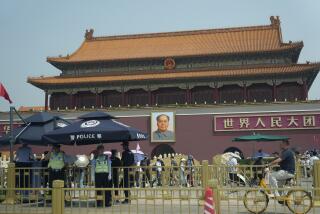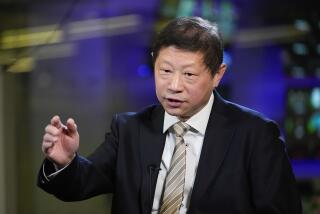Tiananmen Square attack sows terror in spiritual heart of China

The route taken by the car that drove onto Beijing’s Tiananmen Square. At the 5-second mark is the spot where the car went onto the sidewalk; the video, taken Monday from a bus, ends where the car wound up, near the iconic image of Mao Tse-tung.
BEIJING--It could hardly have been a more audacious attack or one that was aimed more directly at the bull’s-eye that is the spiritual heart of China.
At 12:05 p.m. Monday, a white sport utility vehicle entered a sidewalk and drove nearly 500 yards, plowing through tourists and police, until it stopped near the iconic portrait of Mao Tse-tung that hangs over the main gate in front of Tiananmen Square.
The Chinese state news reported that five people were killed and 38 injured. The dead included the three occupants of the car and two tourists, one a Filipina woman and the other a Chinese man.
There were some suggestions that police were looking at suspects from the Uighur community, Muslims from the northwest of China.
A purported police notice put out Monday, apparently after the incident, advised Beijing hotel owners to look out for a 25-year-old and a 42-year-old man from the towns of Pichan and Lukchun, who have been involved in deadly tit-for-tat violence since the summer. The notice, which was published on the Baidu.com Internet site, referred to an unspecified incident in Beijing, and said that the men had at least one light-colored SUV and several license plates.
Few other details were forthcoming from the official Chinese news organs and photographs were scrubbed clean from the Internet.
Nelson Bunyi, a Filipino tourist who survived the attack with a fractured leg, said he had been on the sidewalk with his wife and two daughters when they spotted the vehicle heading toward them.
“A lot of people were running and jumping, but it was too late for me,” said Bunyi, who was flat on his back in the hospital, oxygen tubes in his nose. “It was a white car and it was coming very, very fast. I fell to the ground. I remember there was smoke, not much else.”
The interview was interrupted when police, who were stationed in the hallway outside the hospital room, said the patient could not be questioned without written permission.
The Xinhua news service said only that the causes of the incident were “under investigation.” The circumstances, however, suggested that it was a deliberate attack at one of the most closely guarded locations in China.
At all times, Tiananmen Square is blanketed with paramilitary and police, uniformed and plain-clothed, mingling in the crowds. Cameras record every motion. Separating the street from the sidewalk are 5-foot-high white steel barricades—designed to prevent the type of attack that took place Monday.
However, the white sport utility vehicle appears to have entered at one of the few openings in the barricades, some 500 yards to the east of the square at the intersection of Nanchizi, a street running perpendicular to the main Chang’an Street. The driver then headed along the sidewalk toward the enormous Mao portrait, which hangs over the vermillion-walled “Gate of Heavenly Peace” (or Tiananmen Gate) that leads into the Forbidden City, erstwhile home of China’s emperors.
The vehicle appears to have crashed into a column, bursting in flames. Photographs taken immediately after showed plumes of white and brown smoke rising from the scene. It is unclear whether the car carried explosives or whether it caught fire after being stopped by police.
“The police were unprepared,” wrote one micro blogger, who gave his name as Ma Min, and who claimed to have information from eyewitnesses.
Another, writing under the name Chen Renda, complained, “We have yet to hear the story behind the story. What was the real identity of the people inside the jeep?... Were there weapons found? Were there any pamphlets?”
Best known as the site of the 1989 crackdown on pro-democracy demonstrators, Tiananmen Square is a frequent magnet for protesters and self-immolators. But most plots are foiled far from the square—such as a 2009 incident in which three people set themselves on fire in a car at the Wangfujing pedestrian mall, reportedly over personal grievances with the government.
Most of the injured appeared to have been tourists or police. A nurse at Beijing’s Tongren Hospital said that besides the Filipino family, there was a Japanese tourist and a 5-year-old Chinese boy.
The Chinese government appeared embarrassed by the apparent lapse in security at the heart of the city. There was no mention of the incident on the main 7 p.m. evening news, which led with a report on the 11th meeting of the All China Women’s Federation. A report on the incident ran on the late news.
Beijing police closed off subway stations near the square after the incident and blocked vehicles and journalists.
Using high-pressure water hoses, workers scrubbed the sidewalk clean and there was no trace of fire or explosion. But people knew what happened from the sketchy reports and word of mouth and appeared to be surprised, and a little shaken.
“I can’t believe this is happening in the center of Beijing,” an elderly man in a beret murmured to his wife.
Senior members of the Chinese Communist Party are due to convene next month inside the Great Hall of the People, which is on the west side of the square, for a plenum to chart the nation’s economic future. Mao’s mausoleum lies to the south and Zhongnanhai, the compound of the top leadership, just behind the vermillion walls to the west.
ALSO:
Attackers in Mexico blow up nine electrical plants
Syria meets deadline for plan to destroy chemical arsenal
Afghanistan tragedy: Bomb kills 18 civilians on way to wedding
More to Read
Sign up for Essential California
The most important California stories and recommendations in your inbox every morning.
You may occasionally receive promotional content from the Los Angeles Times.










